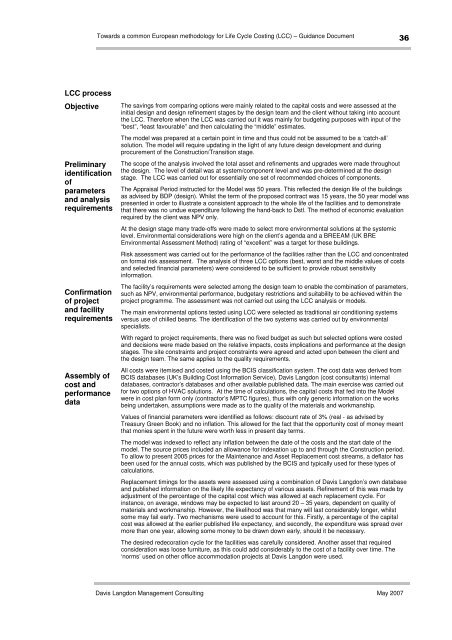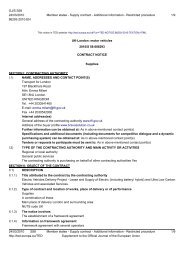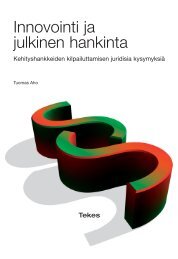Life cycle costing (LCC) as a contribution to sustainable construction ...
Life cycle costing (LCC) as a contribution to sustainable construction ...
Life cycle costing (LCC) as a contribution to sustainable construction ...
Create successful ePaper yourself
Turn your PDF publications into a flip-book with our unique Google optimized e-Paper software.
Towards a common European methodology for <strong>Life</strong> Cycle Costing (<strong>LCC</strong>) – Guidance Document<br />
36<br />
<strong>LCC</strong> process<br />
Objective<br />
Preliminary<br />
identification<br />
of<br />
parameters<br />
and analysis<br />
requirements<br />
Confirmation<br />
of project<br />
and facility<br />
requirements<br />
Assembly of<br />
cost and<br />
performance<br />
data<br />
The savings from comparing options were mainly related <strong>to</strong> the capital costs and were <strong>as</strong>sessed at the<br />
initial design and design refinement stages by the design team and the client without taking in<strong>to</strong> account<br />
the <strong>LCC</strong>. Therefore when the <strong>LCC</strong> w<strong>as</strong> carried out it w<strong>as</strong> mainly for budgeting purposes with input of the<br />
“best”, “le<strong>as</strong>t favourable” and then calculating the “middle” estimates.<br />
The model w<strong>as</strong> prepared at a certain point in time and thus could not be <strong>as</strong>sumed <strong>to</strong> be a ‘catch-all’<br />
solution. The model will require updating in the light of any future design development and during<br />
procurement of the Construction/Transition stage.<br />
The scope of the analysis involved the <strong>to</strong>tal <strong>as</strong>set and refinements and upgrades were made throughout<br />
the design. The level of detail w<strong>as</strong> at system/component level and w<strong>as</strong> pre-determined at the design<br />
stage. The <strong>LCC</strong> w<strong>as</strong> carried out for essentially one set of recommended choices of components.<br />
The Appraisal Period instructed for the Model w<strong>as</strong> 50 years. This reflected the design life of the buildings<br />
<strong>as</strong> advised by BDP (design). Whilst the term of the proposed contract w<strong>as</strong> 15 years, the 50 year model w<strong>as</strong><br />
presented in order <strong>to</strong> illustrate a consistent approach <strong>to</strong> the whole life of the facilities and <strong>to</strong> demonstrate<br />
that there w<strong>as</strong> no undue expenditure following the hand-back <strong>to</strong> Dstl. The method of economic evaluation<br />
required by the client w<strong>as</strong> NPV only.<br />
At the design stage many trade-offs were made <strong>to</strong> select more environmental solutions at the systemic<br />
level. Environmental considerations were high on the client’s agenda and a BREEAM (UK BRE<br />
Environmental Assessment Method) rating of “excellent” w<strong>as</strong> a target for these buildings.<br />
Risk <strong>as</strong>sessment w<strong>as</strong> carried out for the performance of the facilities rather than the <strong>LCC</strong> and concentrated<br />
on formal risk <strong>as</strong>sessment. The analysis of three <strong>LCC</strong> options (best, worst and the middle values of costs<br />
and selected financial parameters) were considered <strong>to</strong> be sufficient <strong>to</strong> provide robust sensitivity<br />
information.<br />
The facility’s requirements were selected among the design team <strong>to</strong> enable the combination of parameters,<br />
such <strong>as</strong> NPV, environmental performance, budgetary restrictions and suitability <strong>to</strong> be achieved within the<br />
project programme. The <strong>as</strong>sessment w<strong>as</strong> not carried out using the <strong>LCC</strong> analysis or models.<br />
The main environmental options tested using <strong>LCC</strong> were selected <strong>as</strong> traditional air conditioning systems<br />
versus use of chilled beams. The identification of the two systems w<strong>as</strong> carried out by environmental<br />
specialists.<br />
With regard <strong>to</strong> project requirements, there w<strong>as</strong> no fixed budget <strong>as</strong> such but selected options were costed<br />
and decisions were made b<strong>as</strong>ed on the relative impacts, costs implications and performance at the design<br />
stages. The site constraints and project constraints were agreed and acted upon between the client and<br />
the design team. The same applies <strong>to</strong> the quality requirements.<br />
All costs were itemised and costed using the BCIS cl<strong>as</strong>sification system. The cost data w<strong>as</strong> derived from<br />
BCIS datab<strong>as</strong>es (UK’s Building Cost Information Service), Davis Langdon (cost consultants) internal<br />
datab<strong>as</strong>es, contrac<strong>to</strong>r’s datab<strong>as</strong>es and other available published data. The main exercise w<strong>as</strong> carried out<br />
for two options of HVAC solutions. At the time of calculations, the capital costs that fed in<strong>to</strong> the Model<br />
were in cost plan form only (contrac<strong>to</strong>r’s MPTC figures), thus with only generic information on the works<br />
being undertaken, <strong>as</strong>sumptions were made <strong>as</strong> <strong>to</strong> the quality of the materials and workmanship.<br />
Values of financial parameters were identified <strong>as</strong> follows: discount rate of 3% (real - <strong>as</strong> advised by<br />
Tre<strong>as</strong>ury Green Book) and no inflation. This allowed for the fact that the opportunity cost of money meant<br />
that monies spent in the future were worth less in present day terms.<br />
The model w<strong>as</strong> indexed <strong>to</strong> reflect any inflation between the date of the costs and the start date of the<br />
model. The source prices included an allowance for indexation up <strong>to</strong> and through the Construction period.<br />
To allow <strong>to</strong> present 2005 prices for the Maintenance and Asset Replacement cost streams, a defla<strong>to</strong>r h<strong>as</strong><br />
been used for the annual costs, which w<strong>as</strong> published by the BCIS and typically used for these types of<br />
calculations.<br />
Replacement timings for the <strong>as</strong>sets were <strong>as</strong>sessed using a combination of Davis Langdon’s own datab<strong>as</strong>e<br />
and published information on the likely life expectancy of various <strong>as</strong>sets. Refinement of this w<strong>as</strong> made by<br />
adjustment of the percentage of the capital cost which w<strong>as</strong> allowed at each replacement <strong>cycle</strong>. For<br />
instance, on average, windows may be expected <strong>to</strong> l<strong>as</strong>t around 20 – 35 years, dependent on quality of<br />
materials and workmanship. However, the likelihood w<strong>as</strong> that many will l<strong>as</strong>t considerably longer, whilst<br />
some may fail early. Two mechanisms were used <strong>to</strong> account for this. Firstly, a percentage of the capital<br />
cost w<strong>as</strong> allowed at the earlier published life expectancy, and secondly, the expenditure w<strong>as</strong> spread over<br />
more than one year, allowing some money <strong>to</strong> be drawn down early, should it be necessary.<br />
The desired redecoration <strong>cycle</strong> for the facilities w<strong>as</strong> carefully considered. Another <strong>as</strong>set that required<br />
consideration w<strong>as</strong> loose furniture, <strong>as</strong> this could add considerably <strong>to</strong> the cost of a facility over time. The<br />
‘norms’ used on other office accommodation projects at Davis Langdon were used.<br />
Davis Langdon Management Consulting May 2007







